Critical Appraisal of a Systematic Review: Preventing Falls Among Older People with Mental Health Problems
VerifiedAdded on 2023/01/10
|12
|3303
|69
AI Summary
This article provides a critical appraisal of a systematic review on preventing falls among older people with mental health problems. It discusses the research question, literature review, study design, quality of the review, results, and implications for future research.
Contribute Materials
Your contribution can guide someone’s learning journey. Share your
documents today.
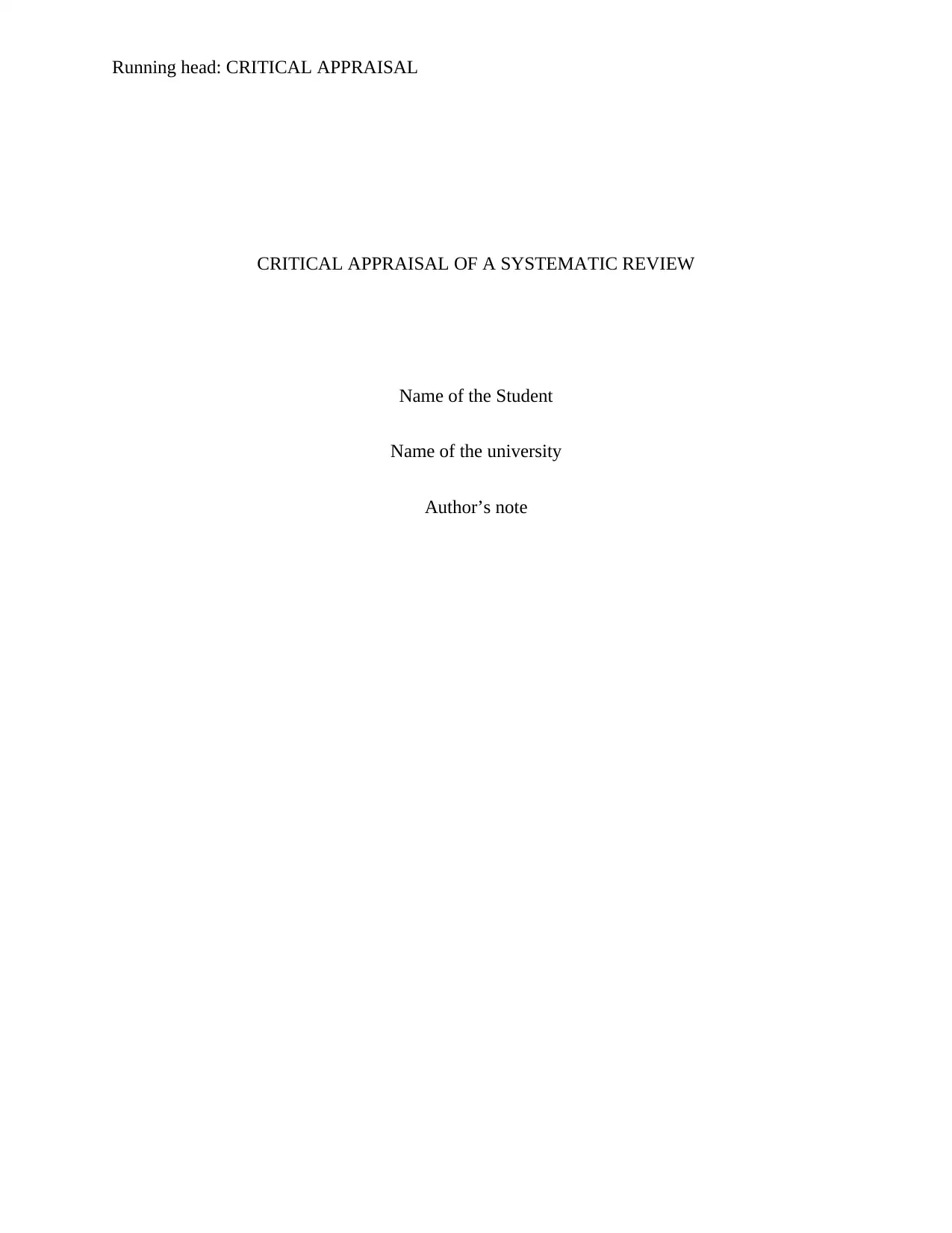
Running head: CRITICAL APPRAISAL
CRITICAL APPRAISAL OF A SYSTEMATIC REVIEW
Name of the Student
Name of the university
Author’s note
CRITICAL APPRAISAL OF A SYSTEMATIC REVIEW
Name of the Student
Name of the university
Author’s note
Secure Best Marks with AI Grader
Need help grading? Try our AI Grader for instant feedback on your assignments.
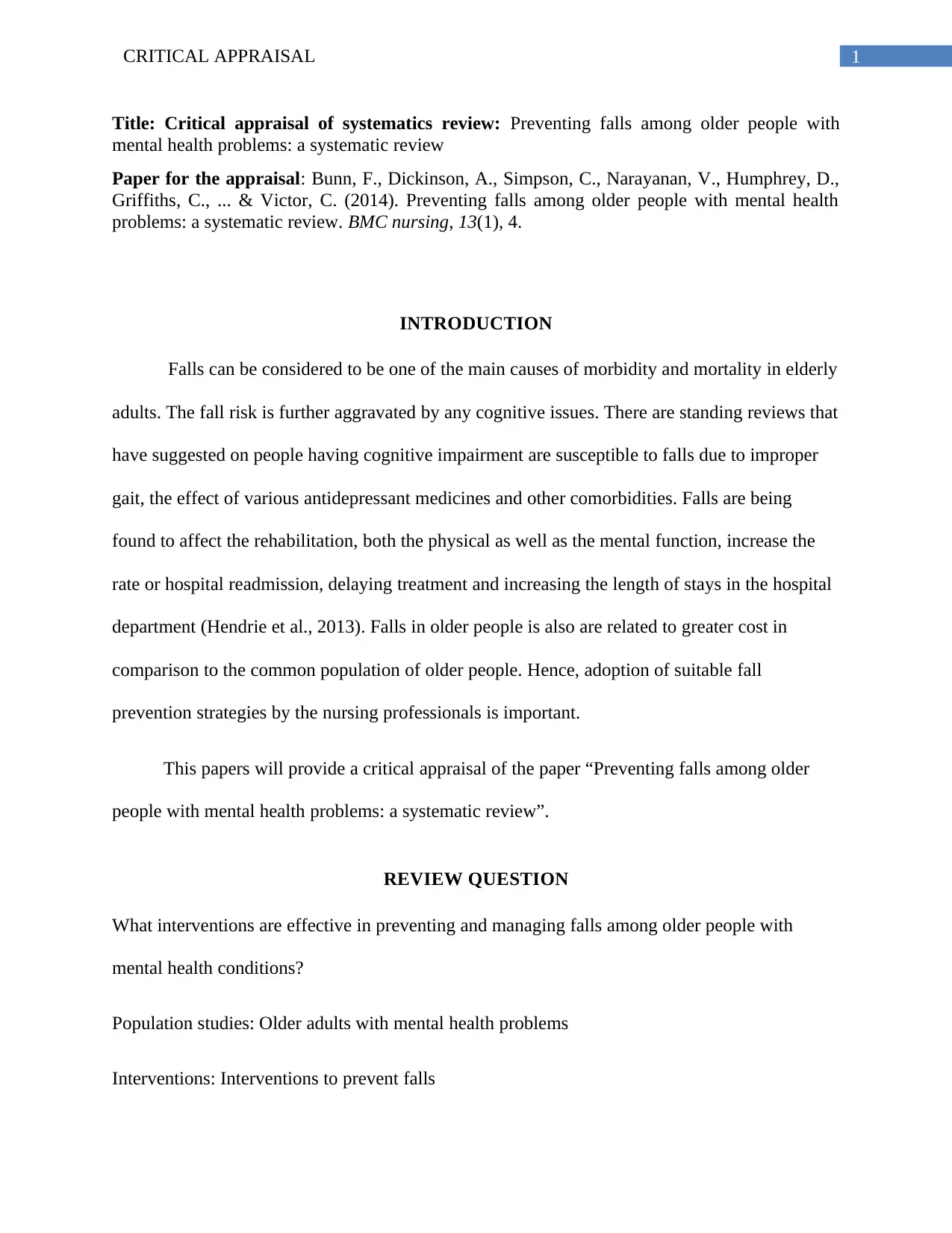
1CRITICAL APPRAISAL
Title: Critical appraisal of systematics review: Preventing falls among older people with
mental health problems: a systematic review
Paper for the appraisal: Bunn, F., Dickinson, A., Simpson, C., Narayanan, V., Humphrey, D.,
Griffiths, C., ... & Victor, C. (2014). Preventing falls among older people with mental health
problems: a systematic review. BMC nursing, 13(1), 4.
INTRODUCTION
Falls can be considered to be one of the main causes of morbidity and mortality in elderly
adults. The fall risk is further aggravated by any cognitive issues. There are standing reviews that
have suggested on people having cognitive impairment are susceptible to falls due to improper
gait, the effect of various antidepressant medicines and other comorbidities. Falls are being
found to affect the rehabilitation, both the physical as well as the mental function, increase the
rate or hospital readmission, delaying treatment and increasing the length of stays in the hospital
department (Hendrie et al., 2013). Falls in older people is also are related to greater cost in
comparison to the common population of older people. Hence, adoption of suitable fall
prevention strategies by the nursing professionals is important.
This papers will provide a critical appraisal of the paper “Preventing falls among older
people with mental health problems: a systematic review”.
REVIEW QUESTION
What interventions are effective in preventing and managing falls among older people with
mental health conditions?
Population studies: Older adults with mental health problems
Interventions: Interventions to prevent falls
Title: Critical appraisal of systematics review: Preventing falls among older people with
mental health problems: a systematic review
Paper for the appraisal: Bunn, F., Dickinson, A., Simpson, C., Narayanan, V., Humphrey, D.,
Griffiths, C., ... & Victor, C. (2014). Preventing falls among older people with mental health
problems: a systematic review. BMC nursing, 13(1), 4.
INTRODUCTION
Falls can be considered to be one of the main causes of morbidity and mortality in elderly
adults. The fall risk is further aggravated by any cognitive issues. There are standing reviews that
have suggested on people having cognitive impairment are susceptible to falls due to improper
gait, the effect of various antidepressant medicines and other comorbidities. Falls are being
found to affect the rehabilitation, both the physical as well as the mental function, increase the
rate or hospital readmission, delaying treatment and increasing the length of stays in the hospital
department (Hendrie et al., 2013). Falls in older people is also are related to greater cost in
comparison to the common population of older people. Hence, adoption of suitable fall
prevention strategies by the nursing professionals is important.
This papers will provide a critical appraisal of the paper “Preventing falls among older
people with mental health problems: a systematic review”.
REVIEW QUESTION
What interventions are effective in preventing and managing falls among older people with
mental health conditions?
Population studies: Older adults with mental health problems
Interventions: Interventions to prevent falls
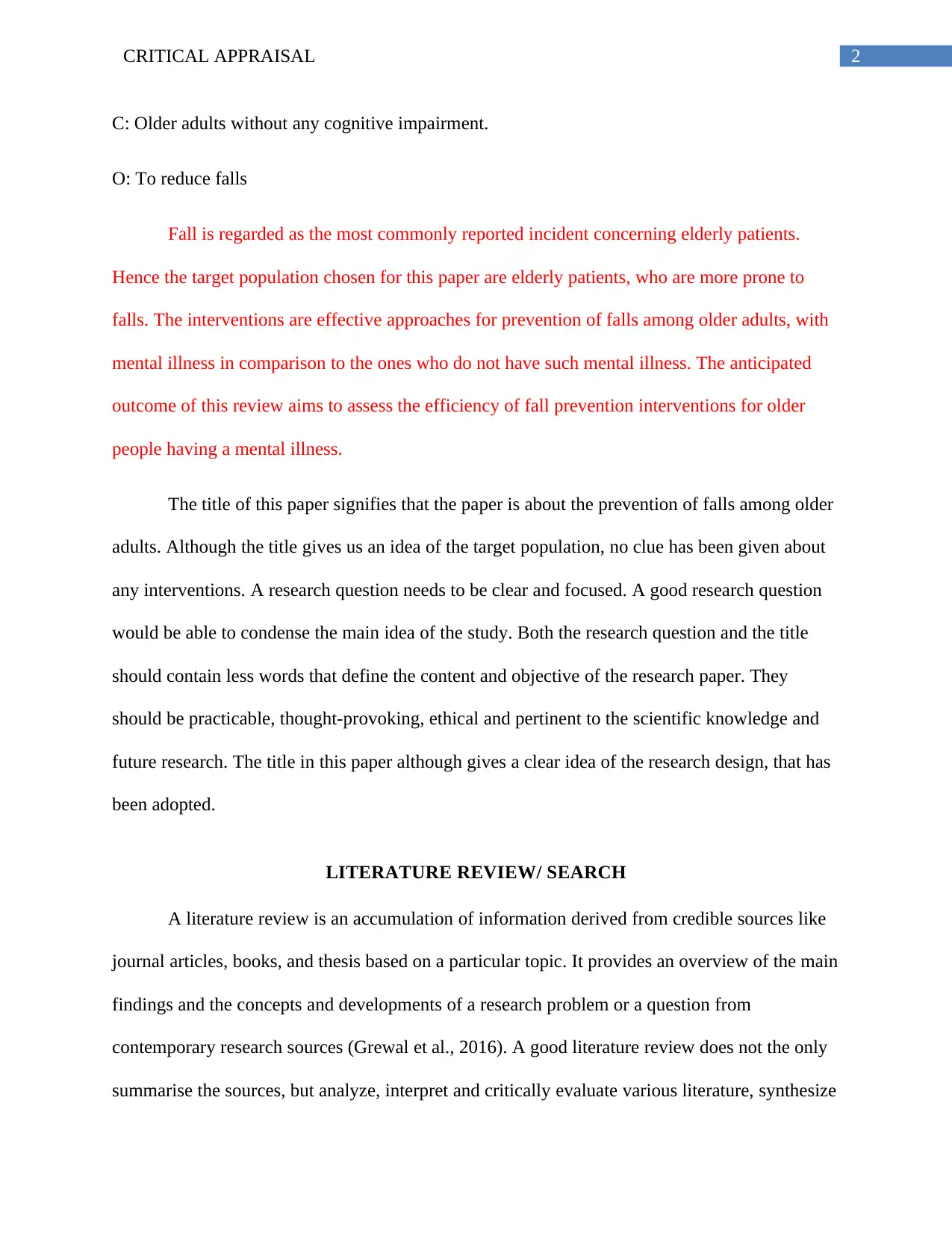
2CRITICAL APPRAISAL
C: Older adults without any cognitive impairment.
O: To reduce falls
Fall is regarded as the most commonly reported incident concerning elderly patients.
Hence the target population chosen for this paper are elderly patients, who are more prone to
falls. The interventions are effective approaches for prevention of falls among older adults, with
mental illness in comparison to the ones who do not have such mental illness. The anticipated
outcome of this review aims to assess the efficiency of fall prevention interventions for older
people having a mental illness.
The title of this paper signifies that the paper is about the prevention of falls among older
adults. Although the title gives us an idea of the target population, no clue has been given about
any interventions. A research question needs to be clear and focused. A good research question
would be able to condense the main idea of the study. Both the research question and the title
should contain less words that define the content and objective of the research paper. They
should be practicable, thought-provoking, ethical and pertinent to the scientific knowledge and
future research. The title in this paper although gives a clear idea of the research design, that has
been adopted.
LITERATURE REVIEW/ SEARCH
A literature review is an accumulation of information derived from credible sources like
journal articles, books, and thesis based on a particular topic. It provides an overview of the main
findings and the concepts and developments of a research problem or a question from
contemporary research sources (Grewal et al., 2016). A good literature review does not the only
summarise the sources, but analyze, interpret and critically evaluate various literature, synthesize
C: Older adults without any cognitive impairment.
O: To reduce falls
Fall is regarded as the most commonly reported incident concerning elderly patients.
Hence the target population chosen for this paper are elderly patients, who are more prone to
falls. The interventions are effective approaches for prevention of falls among older adults, with
mental illness in comparison to the ones who do not have such mental illness. The anticipated
outcome of this review aims to assess the efficiency of fall prevention interventions for older
people having a mental illness.
The title of this paper signifies that the paper is about the prevention of falls among older
adults. Although the title gives us an idea of the target population, no clue has been given about
any interventions. A research question needs to be clear and focused. A good research question
would be able to condense the main idea of the study. Both the research question and the title
should contain less words that define the content and objective of the research paper. They
should be practicable, thought-provoking, ethical and pertinent to the scientific knowledge and
future research. The title in this paper although gives a clear idea of the research design, that has
been adopted.
LITERATURE REVIEW/ SEARCH
A literature review is an accumulation of information derived from credible sources like
journal articles, books, and thesis based on a particular topic. It provides an overview of the main
findings and the concepts and developments of a research problem or a question from
contemporary research sources (Grewal et al., 2016). A good literature review does not the only
summarise the sources, but analyze, interpret and critically evaluate various literature, synthesize
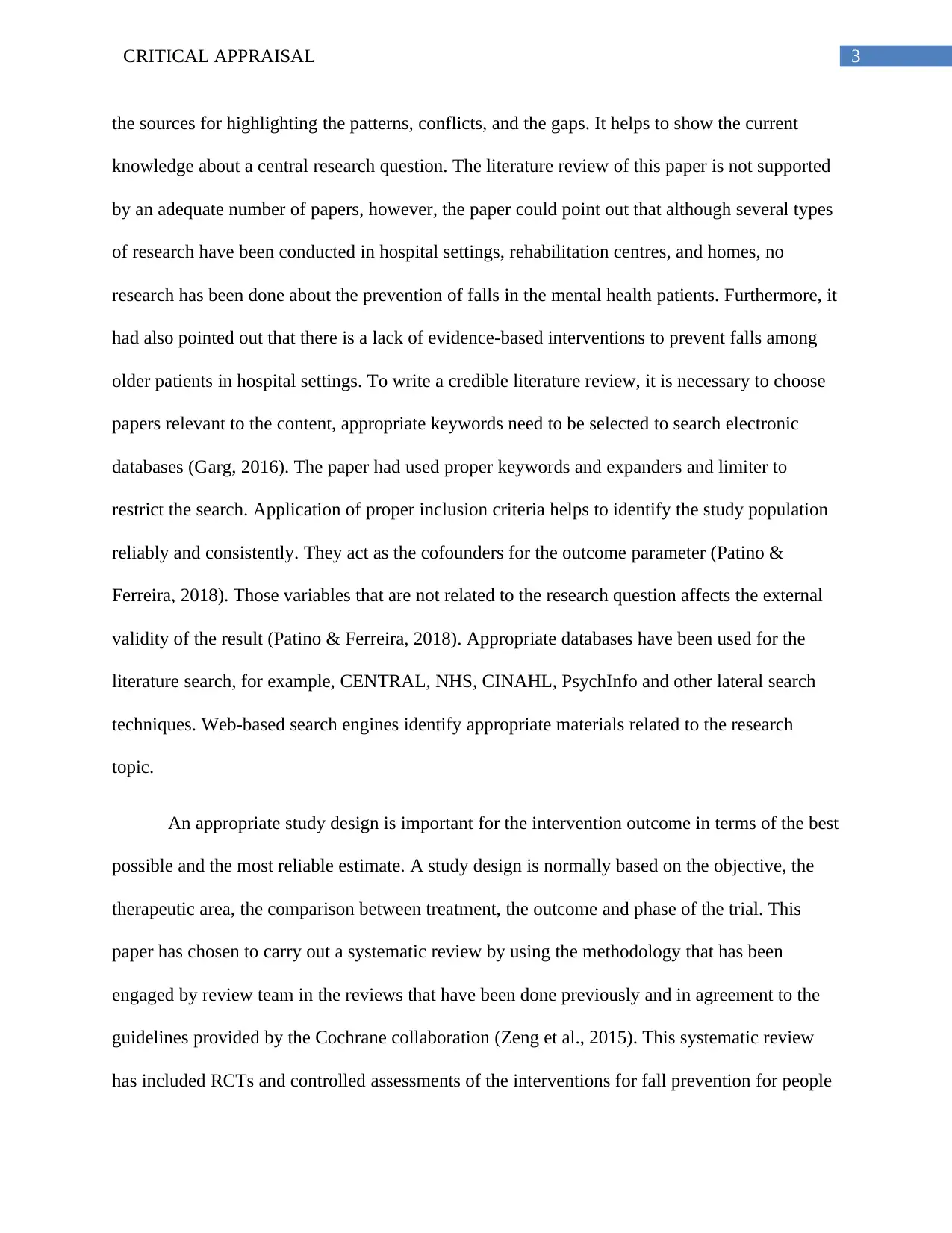
3CRITICAL APPRAISAL
the sources for highlighting the patterns, conflicts, and the gaps. It helps to show the current
knowledge about a central research question. The literature review of this paper is not supported
by an adequate number of papers, however, the paper could point out that although several types
of research have been conducted in hospital settings, rehabilitation centres, and homes, no
research has been done about the prevention of falls in the mental health patients. Furthermore, it
had also pointed out that there is a lack of evidence-based interventions to prevent falls among
older patients in hospital settings. To write a credible literature review, it is necessary to choose
papers relevant to the content, appropriate keywords need to be selected to search electronic
databases (Garg, 2016). The paper had used proper keywords and expanders and limiter to
restrict the search. Application of proper inclusion criteria helps to identify the study population
reliably and consistently. They act as the cofounders for the outcome parameter (Patino &
Ferreira, 2018). Those variables that are not related to the research question affects the external
validity of the result (Patino & Ferreira, 2018). Appropriate databases have been used for the
literature search, for example, CENTRAL, NHS, CINAHL, PsychInfo and other lateral search
techniques. Web-based search engines identify appropriate materials related to the research
topic.
An appropriate study design is important for the intervention outcome in terms of the best
possible and the most reliable estimate. A study design is normally based on the objective, the
therapeutic area, the comparison between treatment, the outcome and phase of the trial. This
paper has chosen to carry out a systematic review by using the methodology that has been
engaged by review team in the reviews that have been done previously and in agreement to the
guidelines provided by the Cochrane collaboration (Zeng et al., 2015). This systematic review
has included RCTs and controlled assessments of the interventions for fall prevention for people
the sources for highlighting the patterns, conflicts, and the gaps. It helps to show the current
knowledge about a central research question. The literature review of this paper is not supported
by an adequate number of papers, however, the paper could point out that although several types
of research have been conducted in hospital settings, rehabilitation centres, and homes, no
research has been done about the prevention of falls in the mental health patients. Furthermore, it
had also pointed out that there is a lack of evidence-based interventions to prevent falls among
older patients in hospital settings. To write a credible literature review, it is necessary to choose
papers relevant to the content, appropriate keywords need to be selected to search electronic
databases (Garg, 2016). The paper had used proper keywords and expanders and limiter to
restrict the search. Application of proper inclusion criteria helps to identify the study population
reliably and consistently. They act as the cofounders for the outcome parameter (Patino &
Ferreira, 2018). Those variables that are not related to the research question affects the external
validity of the result (Patino & Ferreira, 2018). Appropriate databases have been used for the
literature search, for example, CENTRAL, NHS, CINAHL, PsychInfo and other lateral search
techniques. Web-based search engines identify appropriate materials related to the research
topic.
An appropriate study design is important for the intervention outcome in terms of the best
possible and the most reliable estimate. A study design is normally based on the objective, the
therapeutic area, the comparison between treatment, the outcome and phase of the trial. This
paper has chosen to carry out a systematic review by using the methodology that has been
engaged by review team in the reviews that have been done previously and in agreement to the
guidelines provided by the Cochrane collaboration (Zeng et al., 2015). This systematic review
has included RCTs and controlled assessments of the interventions for fall prevention for people
Secure Best Marks with AI Grader
Need help grading? Try our AI Grader for instant feedback on your assignments.
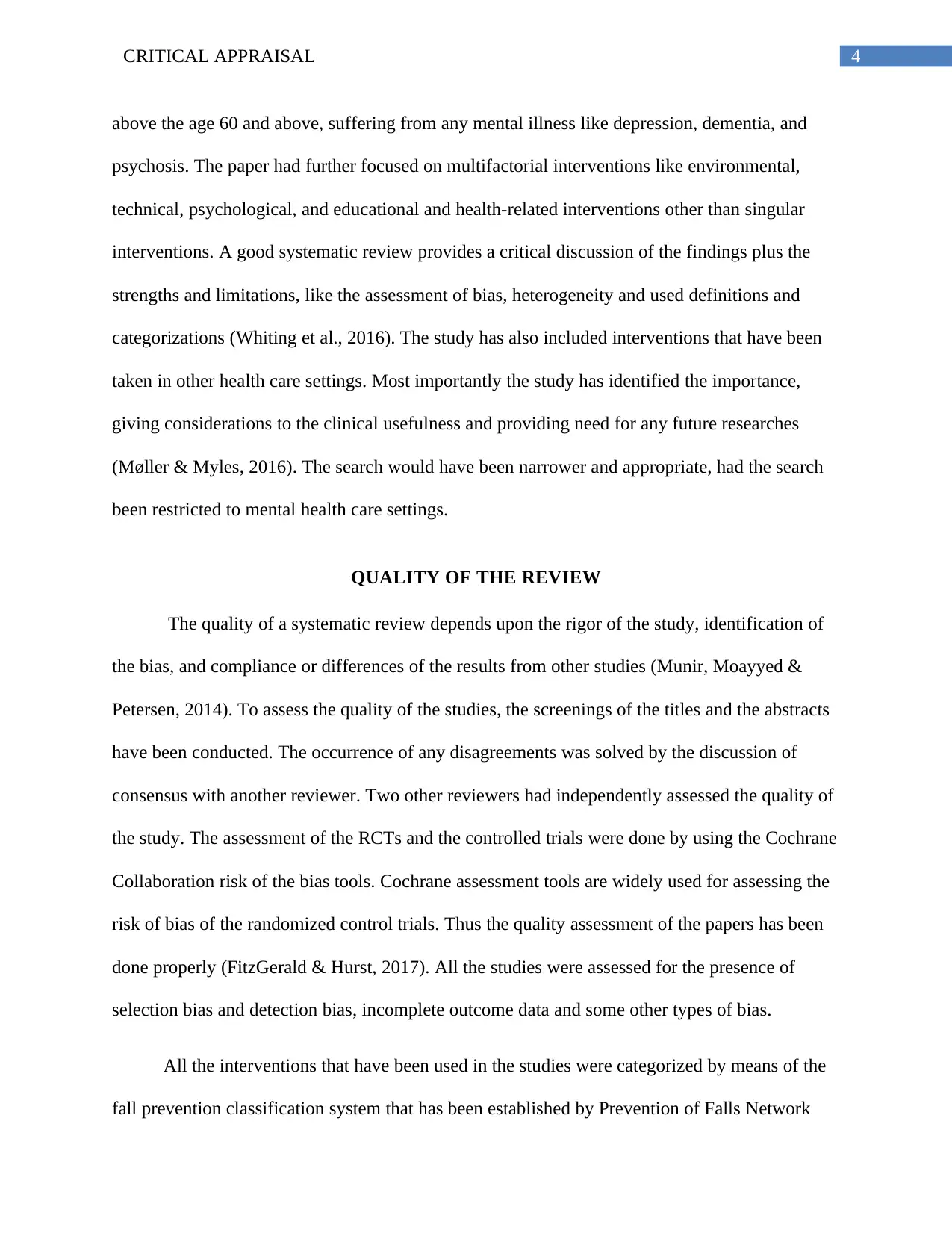
4CRITICAL APPRAISAL
above the age 60 and above, suffering from any mental illness like depression, dementia, and
psychosis. The paper had further focused on multifactorial interventions like environmental,
technical, psychological, and educational and health-related interventions other than singular
interventions. A good systematic review provides a critical discussion of the findings plus the
strengths and limitations, like the assessment of bias, heterogeneity and used definitions and
categorizations (Whiting et al., 2016). The study has also included interventions that have been
taken in other health care settings. Most importantly the study has identified the importance,
giving considerations to the clinical usefulness and providing need for any future researches
(Møller & Myles, 2016). The search would have been narrower and appropriate, had the search
been restricted to mental health care settings.
QUALITY OF THE REVIEW
The quality of a systematic review depends upon the rigor of the study, identification of
the bias, and compliance or differences of the results from other studies (Munir, Moayyed &
Petersen, 2014). To assess the quality of the studies, the screenings of the titles and the abstracts
have been conducted. The occurrence of any disagreements was solved by the discussion of
consensus with another reviewer. Two other reviewers had independently assessed the quality of
the study. The assessment of the RCTs and the controlled trials were done by using the Cochrane
Collaboration risk of the bias tools. Cochrane assessment tools are widely used for assessing the
risk of bias of the randomized control trials. Thus the quality assessment of the papers has been
done properly (FitzGerald & Hurst, 2017). All the studies were assessed for the presence of
selection bias and detection bias, incomplete outcome data and some other types of bias.
All the interventions that have been used in the studies were categorized by means of the
fall prevention classification system that has been established by Prevention of Falls Network
above the age 60 and above, suffering from any mental illness like depression, dementia, and
psychosis. The paper had further focused on multifactorial interventions like environmental,
technical, psychological, and educational and health-related interventions other than singular
interventions. A good systematic review provides a critical discussion of the findings plus the
strengths and limitations, like the assessment of bias, heterogeneity and used definitions and
categorizations (Whiting et al., 2016). The study has also included interventions that have been
taken in other health care settings. Most importantly the study has identified the importance,
giving considerations to the clinical usefulness and providing need for any future researches
(Møller & Myles, 2016). The search would have been narrower and appropriate, had the search
been restricted to mental health care settings.
QUALITY OF THE REVIEW
The quality of a systematic review depends upon the rigor of the study, identification of
the bias, and compliance or differences of the results from other studies (Munir, Moayyed &
Petersen, 2014). To assess the quality of the studies, the screenings of the titles and the abstracts
have been conducted. The occurrence of any disagreements was solved by the discussion of
consensus with another reviewer. Two other reviewers had independently assessed the quality of
the study. The assessment of the RCTs and the controlled trials were done by using the Cochrane
Collaboration risk of the bias tools. Cochrane assessment tools are widely used for assessing the
risk of bias of the randomized control trials. Thus the quality assessment of the papers has been
done properly (FitzGerald & Hurst, 2017). All the studies were assessed for the presence of
selection bias and detection bias, incomplete outcome data and some other types of bias.
All the interventions that have been used in the studies were categorized by means of the
fall prevention classification system that has been established by Prevention of Falls Network
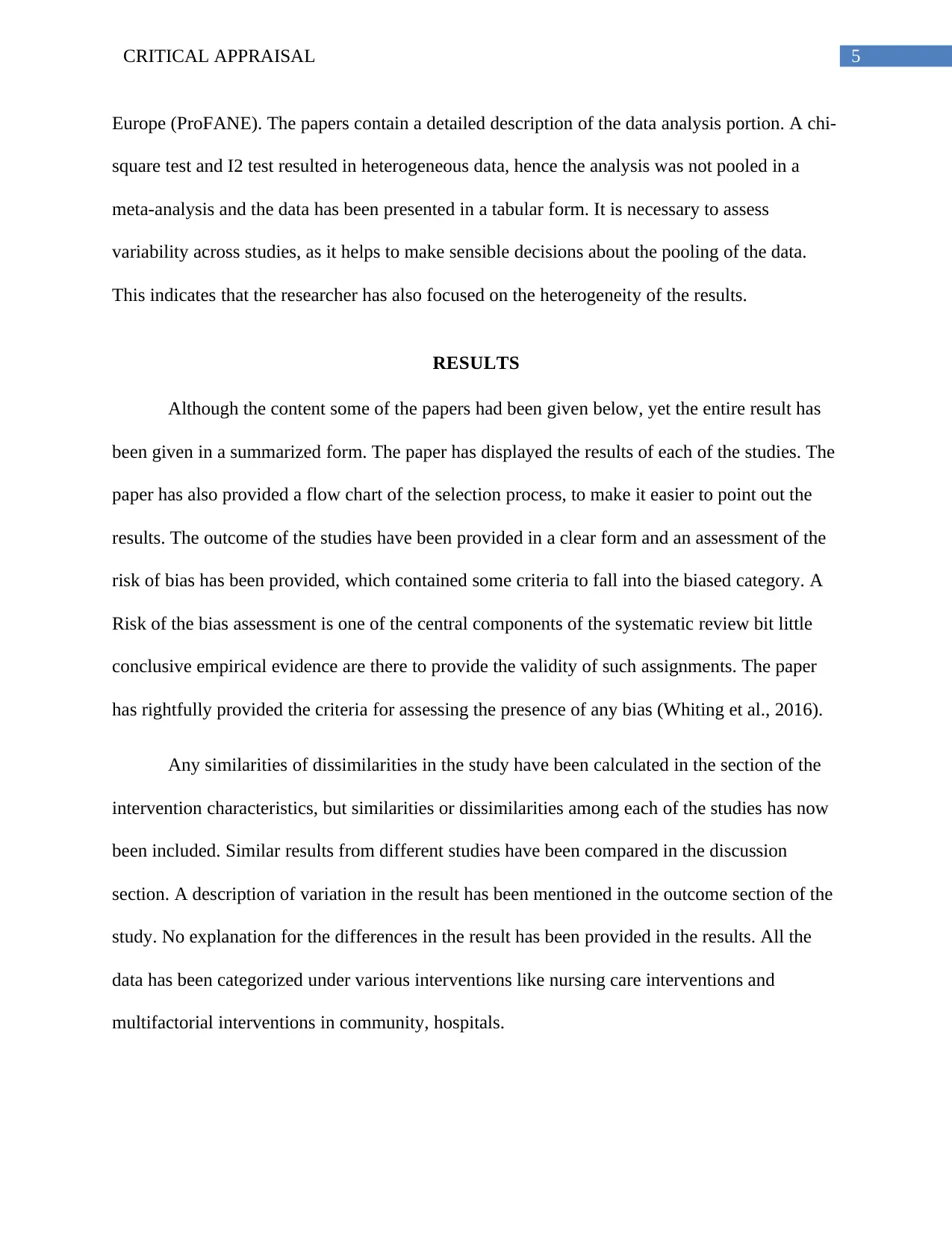
5CRITICAL APPRAISAL
Europe (ProFANE). The papers contain a detailed description of the data analysis portion. A chi-
square test and I2 test resulted in heterogeneous data, hence the analysis was not pooled in a
meta-analysis and the data has been presented in a tabular form. It is necessary to assess
variability across studies, as it helps to make sensible decisions about the pooling of the data.
This indicates that the researcher has also focused on the heterogeneity of the results.
RESULTS
Although the content some of the papers had been given below, yet the entire result has
been given in a summarized form. The paper has displayed the results of each of the studies. The
paper has also provided a flow chart of the selection process, to make it easier to point out the
results. The outcome of the studies have been provided in a clear form and an assessment of the
risk of bias has been provided, which contained some criteria to fall into the biased category. A
Risk of the bias assessment is one of the central components of the systematic review bit little
conclusive empirical evidence are there to provide the validity of such assignments. The paper
has rightfully provided the criteria for assessing the presence of any bias (Whiting et al., 2016).
Any similarities of dissimilarities in the study have been calculated in the section of the
intervention characteristics, but similarities or dissimilarities among each of the studies has now
been included. Similar results from different studies have been compared in the discussion
section. A description of variation in the result has been mentioned in the outcome section of the
study. No explanation for the differences in the result has been provided in the results. All the
data has been categorized under various interventions like nursing care interventions and
multifactorial interventions in community, hospitals.
Europe (ProFANE). The papers contain a detailed description of the data analysis portion. A chi-
square test and I2 test resulted in heterogeneous data, hence the analysis was not pooled in a
meta-analysis and the data has been presented in a tabular form. It is necessary to assess
variability across studies, as it helps to make sensible decisions about the pooling of the data.
This indicates that the researcher has also focused on the heterogeneity of the results.
RESULTS
Although the content some of the papers had been given below, yet the entire result has
been given in a summarized form. The paper has displayed the results of each of the studies. The
paper has also provided a flow chart of the selection process, to make it easier to point out the
results. The outcome of the studies have been provided in a clear form and an assessment of the
risk of bias has been provided, which contained some criteria to fall into the biased category. A
Risk of the bias assessment is one of the central components of the systematic review bit little
conclusive empirical evidence are there to provide the validity of such assignments. The paper
has rightfully provided the criteria for assessing the presence of any bias (Whiting et al., 2016).
Any similarities of dissimilarities in the study have been calculated in the section of the
intervention characteristics, but similarities or dissimilarities among each of the studies has now
been included. Similar results from different studies have been compared in the discussion
section. A description of variation in the result has been mentioned in the outcome section of the
study. No explanation for the differences in the result has been provided in the results. All the
data has been categorized under various interventions like nursing care interventions and
multifactorial interventions in community, hospitals.
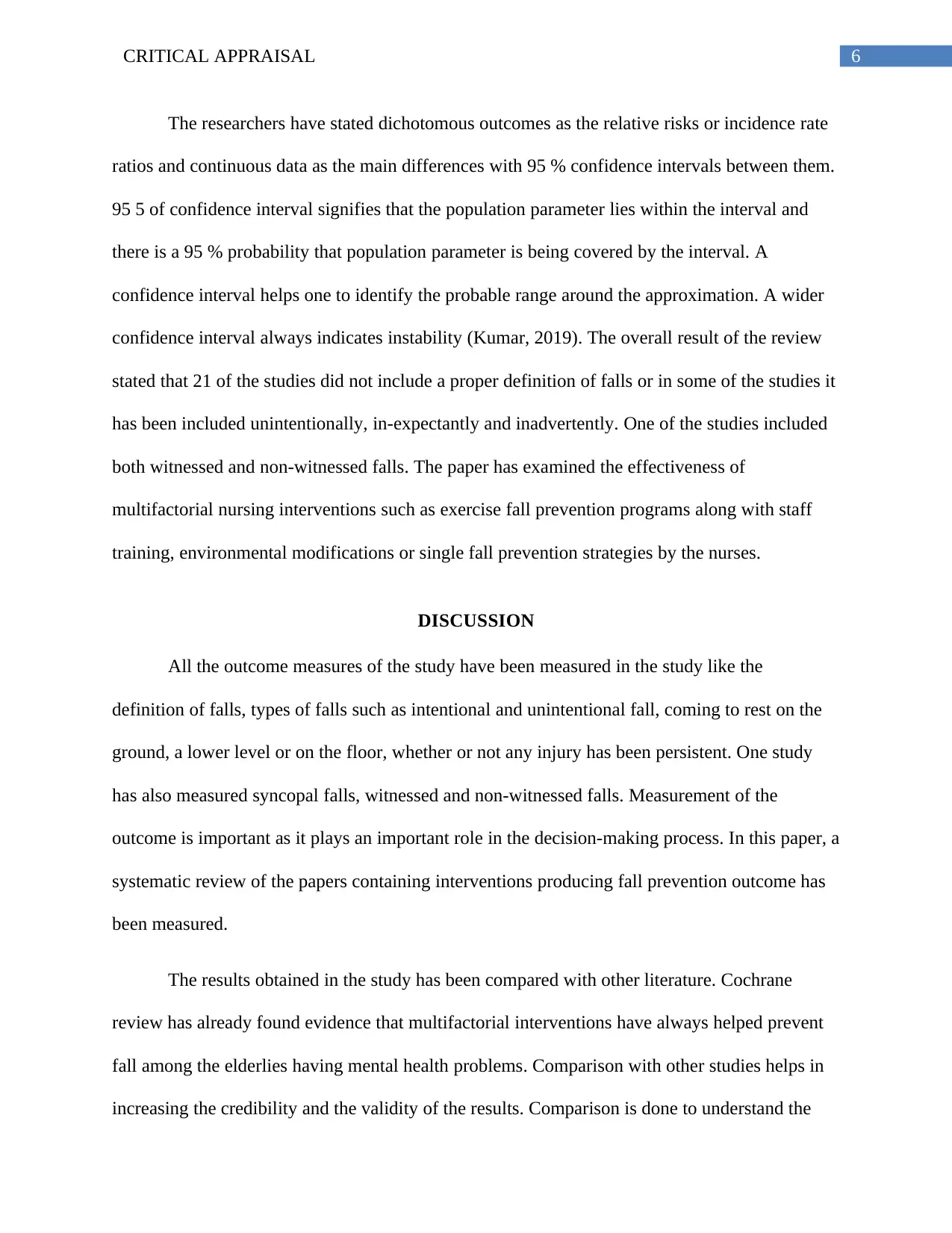
6CRITICAL APPRAISAL
The researchers have stated dichotomous outcomes as the relative risks or incidence rate
ratios and continuous data as the main differences with 95 % confidence intervals between them.
95 5 of confidence interval signifies that the population parameter lies within the interval and
there is a 95 % probability that population parameter is being covered by the interval. A
confidence interval helps one to identify the probable range around the approximation. A wider
confidence interval always indicates instability (Kumar, 2019). The overall result of the review
stated that 21 of the studies did not include a proper definition of falls or in some of the studies it
has been included unintentionally, in-expectantly and inadvertently. One of the studies included
both witnessed and non-witnessed falls. The paper has examined the effectiveness of
multifactorial nursing interventions such as exercise fall prevention programs along with staff
training, environmental modifications or single fall prevention strategies by the nurses.
DISCUSSION
All the outcome measures of the study have been measured in the study like the
definition of falls, types of falls such as intentional and unintentional fall, coming to rest on the
ground, a lower level or on the floor, whether or not any injury has been persistent. One study
has also measured syncopal falls, witnessed and non-witnessed falls. Measurement of the
outcome is important as it plays an important role in the decision-making process. In this paper, a
systematic review of the papers containing interventions producing fall prevention outcome has
been measured.
The results obtained in the study has been compared with other literature. Cochrane
review has already found evidence that multifactorial interventions have always helped prevent
fall among the elderlies having mental health problems. Comparison with other studies helps in
increasing the credibility and the validity of the results. Comparison is done to understand the
The researchers have stated dichotomous outcomes as the relative risks or incidence rate
ratios and continuous data as the main differences with 95 % confidence intervals between them.
95 5 of confidence interval signifies that the population parameter lies within the interval and
there is a 95 % probability that population parameter is being covered by the interval. A
confidence interval helps one to identify the probable range around the approximation. A wider
confidence interval always indicates instability (Kumar, 2019). The overall result of the review
stated that 21 of the studies did not include a proper definition of falls or in some of the studies it
has been included unintentionally, in-expectantly and inadvertently. One of the studies included
both witnessed and non-witnessed falls. The paper has examined the effectiveness of
multifactorial nursing interventions such as exercise fall prevention programs along with staff
training, environmental modifications or single fall prevention strategies by the nurses.
DISCUSSION
All the outcome measures of the study have been measured in the study like the
definition of falls, types of falls such as intentional and unintentional fall, coming to rest on the
ground, a lower level or on the floor, whether or not any injury has been persistent. One study
has also measured syncopal falls, witnessed and non-witnessed falls. Measurement of the
outcome is important as it plays an important role in the decision-making process. In this paper, a
systematic review of the papers containing interventions producing fall prevention outcome has
been measured.
The results obtained in the study has been compared with other literature. Cochrane
review has already found evidence that multifactorial interventions have always helped prevent
fall among the elderlies having mental health problems. Comparison with other studies helps in
increasing the credibility and the validity of the results. Comparison is done to understand the
Paraphrase This Document
Need a fresh take? Get an instant paraphrase of this document with our AI Paraphraser
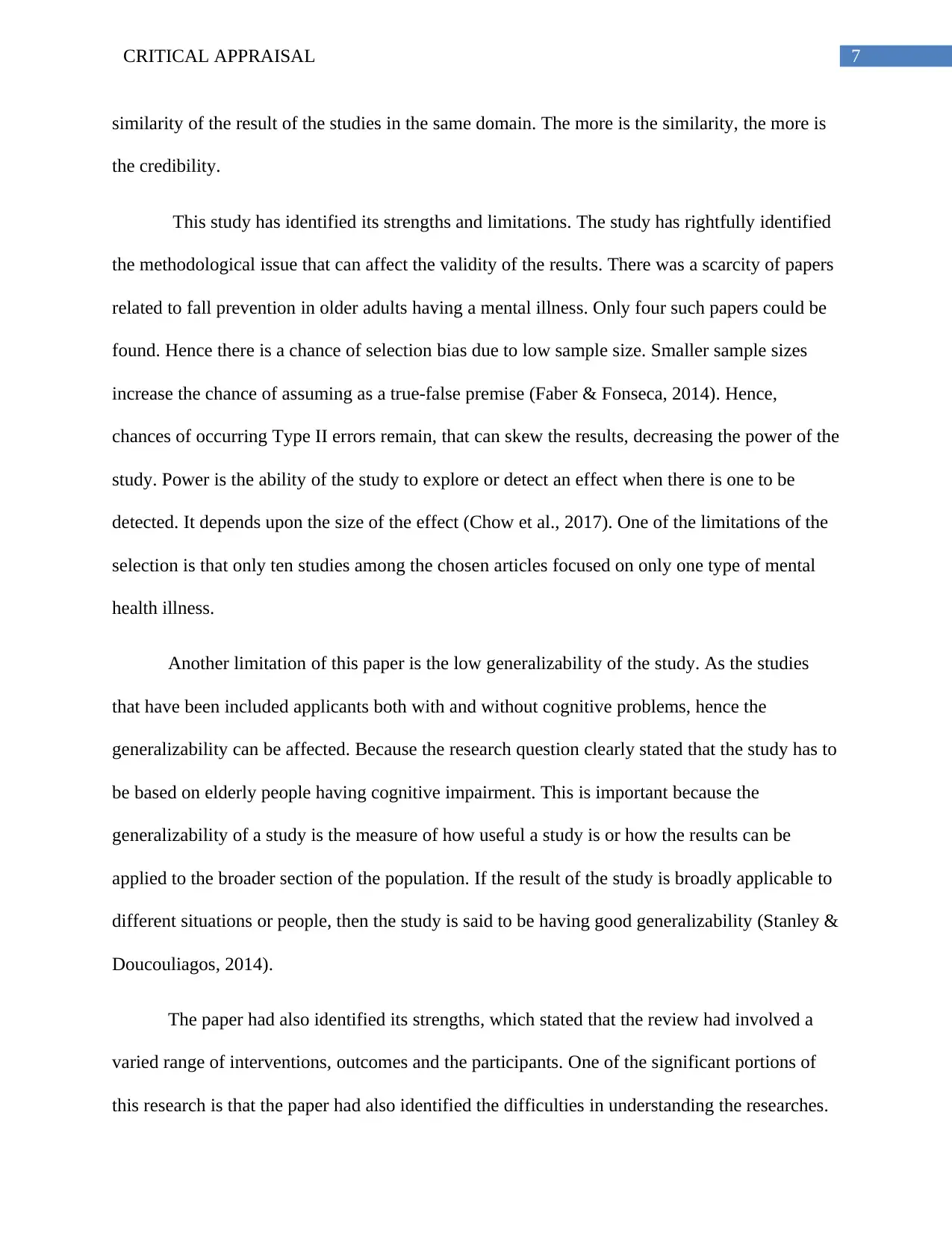
7CRITICAL APPRAISAL
similarity of the result of the studies in the same domain. The more is the similarity, the more is
the credibility.
This study has identified its strengths and limitations. The study has rightfully identified
the methodological issue that can affect the validity of the results. There was a scarcity of papers
related to fall prevention in older adults having a mental illness. Only four such papers could be
found. Hence there is a chance of selection bias due to low sample size. Smaller sample sizes
increase the chance of assuming as a true-false premise (Faber & Fonseca, 2014). Hence,
chances of occurring Type II errors remain, that can skew the results, decreasing the power of the
study. Power is the ability of the study to explore or detect an effect when there is one to be
detected. It depends upon the size of the effect (Chow et al., 2017). One of the limitations of the
selection is that only ten studies among the chosen articles focused on only one type of mental
health illness.
Another limitation of this paper is the low generalizability of the study. As the studies
that have been included applicants both with and without cognitive problems, hence the
generalizability can be affected. Because the research question clearly stated that the study has to
be based on elderly people having cognitive impairment. This is important because the
generalizability of a study is the measure of how useful a study is or how the results can be
applied to the broader section of the population. If the result of the study is broadly applicable to
different situations or people, then the study is said to be having good generalizability (Stanley &
Doucouliagos, 2014).
The paper had also identified its strengths, which stated that the review had involved a
varied range of interventions, outcomes and the participants. One of the significant portions of
this research is that the paper had also identified the difficulties in understanding the researches.
similarity of the result of the studies in the same domain. The more is the similarity, the more is
the credibility.
This study has identified its strengths and limitations. The study has rightfully identified
the methodological issue that can affect the validity of the results. There was a scarcity of papers
related to fall prevention in older adults having a mental illness. Only four such papers could be
found. Hence there is a chance of selection bias due to low sample size. Smaller sample sizes
increase the chance of assuming as a true-false premise (Faber & Fonseca, 2014). Hence,
chances of occurring Type II errors remain, that can skew the results, decreasing the power of the
study. Power is the ability of the study to explore or detect an effect when there is one to be
detected. It depends upon the size of the effect (Chow et al., 2017). One of the limitations of the
selection is that only ten studies among the chosen articles focused on only one type of mental
health illness.
Another limitation of this paper is the low generalizability of the study. As the studies
that have been included applicants both with and without cognitive problems, hence the
generalizability can be affected. Because the research question clearly stated that the study has to
be based on elderly people having cognitive impairment. This is important because the
generalizability of a study is the measure of how useful a study is or how the results can be
applied to the broader section of the population. If the result of the study is broadly applicable to
different situations or people, then the study is said to be having good generalizability (Stanley &
Doucouliagos, 2014).
The paper had also identified its strengths, which stated that the review had involved a
varied range of interventions, outcomes and the participants. One of the significant portions of
this research is that the paper had also identified the difficulties in understanding the researches.
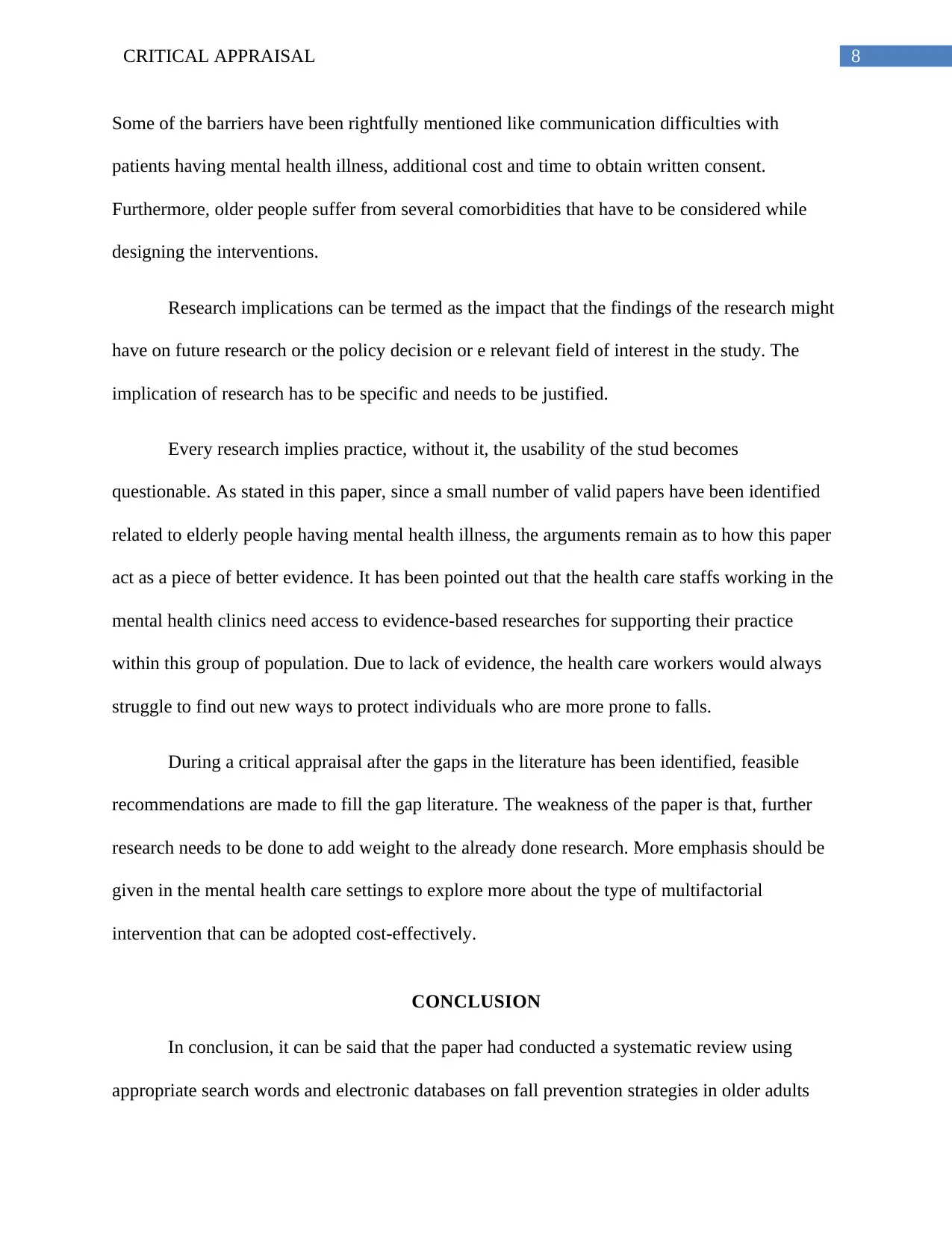
8CRITICAL APPRAISAL
Some of the barriers have been rightfully mentioned like communication difficulties with
patients having mental health illness, additional cost and time to obtain written consent.
Furthermore, older people suffer from several comorbidities that have to be considered while
designing the interventions.
Research implications can be termed as the impact that the findings of the research might
have on future research or the policy decision or e relevant field of interest in the study. The
implication of research has to be specific and needs to be justified.
Every research implies practice, without it, the usability of the stud becomes
questionable. As stated in this paper, since a small number of valid papers have been identified
related to elderly people having mental health illness, the arguments remain as to how this paper
act as a piece of better evidence. It has been pointed out that the health care staffs working in the
mental health clinics need access to evidence-based researches for supporting their practice
within this group of population. Due to lack of evidence, the health care workers would always
struggle to find out new ways to protect individuals who are more prone to falls.
During a critical appraisal after the gaps in the literature has been identified, feasible
recommendations are made to fill the gap literature. The weakness of the paper is that, further
research needs to be done to add weight to the already done research. More emphasis should be
given in the mental health care settings to explore more about the type of multifactorial
intervention that can be adopted cost-effectively.
CONCLUSION
In conclusion, it can be said that the paper had conducted a systematic review using
appropriate search words and electronic databases on fall prevention strategies in older adults
Some of the barriers have been rightfully mentioned like communication difficulties with
patients having mental health illness, additional cost and time to obtain written consent.
Furthermore, older people suffer from several comorbidities that have to be considered while
designing the interventions.
Research implications can be termed as the impact that the findings of the research might
have on future research or the policy decision or e relevant field of interest in the study. The
implication of research has to be specific and needs to be justified.
Every research implies practice, without it, the usability of the stud becomes
questionable. As stated in this paper, since a small number of valid papers have been identified
related to elderly people having mental health illness, the arguments remain as to how this paper
act as a piece of better evidence. It has been pointed out that the health care staffs working in the
mental health clinics need access to evidence-based researches for supporting their practice
within this group of population. Due to lack of evidence, the health care workers would always
struggle to find out new ways to protect individuals who are more prone to falls.
During a critical appraisal after the gaps in the literature has been identified, feasible
recommendations are made to fill the gap literature. The weakness of the paper is that, further
research needs to be done to add weight to the already done research. More emphasis should be
given in the mental health care settings to explore more about the type of multifactorial
intervention that can be adopted cost-effectively.
CONCLUSION
In conclusion, it can be said that the paper had conducted a systematic review using
appropriate search words and electronic databases on fall prevention strategies in older adults

9CRITICAL APPRAISAL
with mental health problems. The paper has not considered an ample number of papers thus
reducing the credibility and the generalizability of the study. However, it was successful in
identifying some effective single and multifactorial interventions, which indicates a scope of
future researches to strengthen the call of multifactorial interventions that have been taken.
with mental health problems. The paper has not considered an ample number of papers thus
reducing the credibility and the generalizability of the study. However, it was successful in
identifying some effective single and multifactorial interventions, which indicates a scope of
future researches to strengthen the call of multifactorial interventions that have been taken.
Secure Best Marks with AI Grader
Need help grading? Try our AI Grader for instant feedback on your assignments.
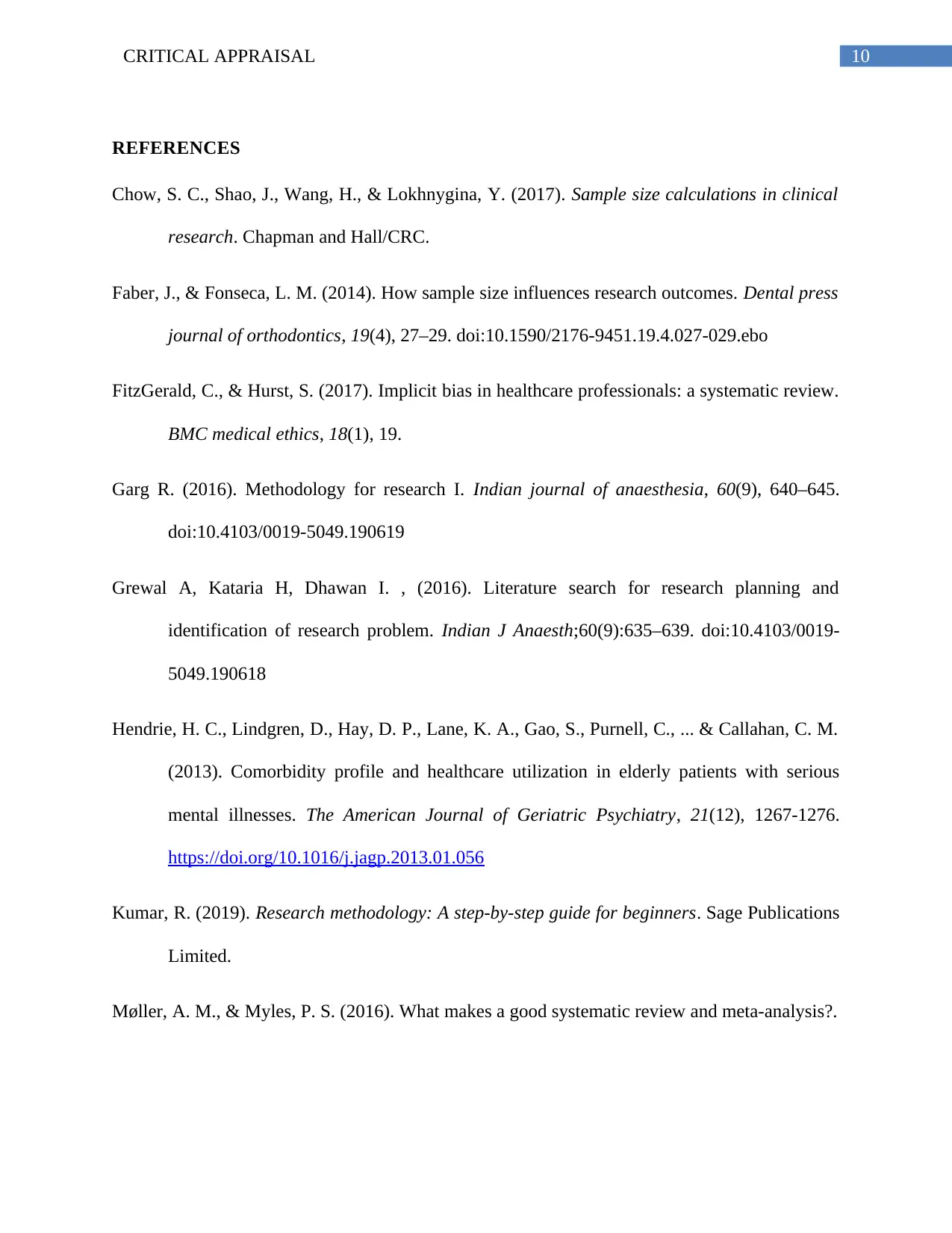
10CRITICAL APPRAISAL
REFERENCES
Chow, S. C., Shao, J., Wang, H., & Lokhnygina, Y. (2017). Sample size calculations in clinical
research. Chapman and Hall/CRC.
Faber, J., & Fonseca, L. M. (2014). How sample size influences research outcomes. Dental press
journal of orthodontics, 19(4), 27–29. doi:10.1590/2176-9451.19.4.027-029.ebo
FitzGerald, C., & Hurst, S. (2017). Implicit bias in healthcare professionals: a systematic review.
BMC medical ethics, 18(1), 19.
Garg R. (2016). Methodology for research I. Indian journal of anaesthesia, 60(9), 640–645.
doi:10.4103/0019-5049.190619
Grewal A, Kataria H, Dhawan I. , (2016). Literature search for research planning and
identification of research problem. Indian J Anaesth;60(9):635–639. doi:10.4103/0019-
5049.190618
Hendrie, H. C., Lindgren, D., Hay, D. P., Lane, K. A., Gao, S., Purnell, C., ... & Callahan, C. M.
(2013). Comorbidity profile and healthcare utilization in elderly patients with serious
mental illnesses. The American Journal of Geriatric Psychiatry, 21(12), 1267-1276.
https://doi.org/10.1016/j.jagp.2013.01.056
Kumar, R. (2019). Research methodology: A step-by-step guide for beginners. Sage Publications
Limited.
Møller, A. M., & Myles, P. S. (2016). What makes a good systematic review and meta-analysis?.
REFERENCES
Chow, S. C., Shao, J., Wang, H., & Lokhnygina, Y. (2017). Sample size calculations in clinical
research. Chapman and Hall/CRC.
Faber, J., & Fonseca, L. M. (2014). How sample size influences research outcomes. Dental press
journal of orthodontics, 19(4), 27–29. doi:10.1590/2176-9451.19.4.027-029.ebo
FitzGerald, C., & Hurst, S. (2017). Implicit bias in healthcare professionals: a systematic review.
BMC medical ethics, 18(1), 19.
Garg R. (2016). Methodology for research I. Indian journal of anaesthesia, 60(9), 640–645.
doi:10.4103/0019-5049.190619
Grewal A, Kataria H, Dhawan I. , (2016). Literature search for research planning and
identification of research problem. Indian J Anaesth;60(9):635–639. doi:10.4103/0019-
5049.190618
Hendrie, H. C., Lindgren, D., Hay, D. P., Lane, K. A., Gao, S., Purnell, C., ... & Callahan, C. M.
(2013). Comorbidity profile and healthcare utilization in elderly patients with serious
mental illnesses. The American Journal of Geriatric Psychiatry, 21(12), 1267-1276.
https://doi.org/10.1016/j.jagp.2013.01.056
Kumar, R. (2019). Research methodology: A step-by-step guide for beginners. Sage Publications
Limited.
Møller, A. M., & Myles, P. S. (2016). What makes a good systematic review and meta-analysis?.
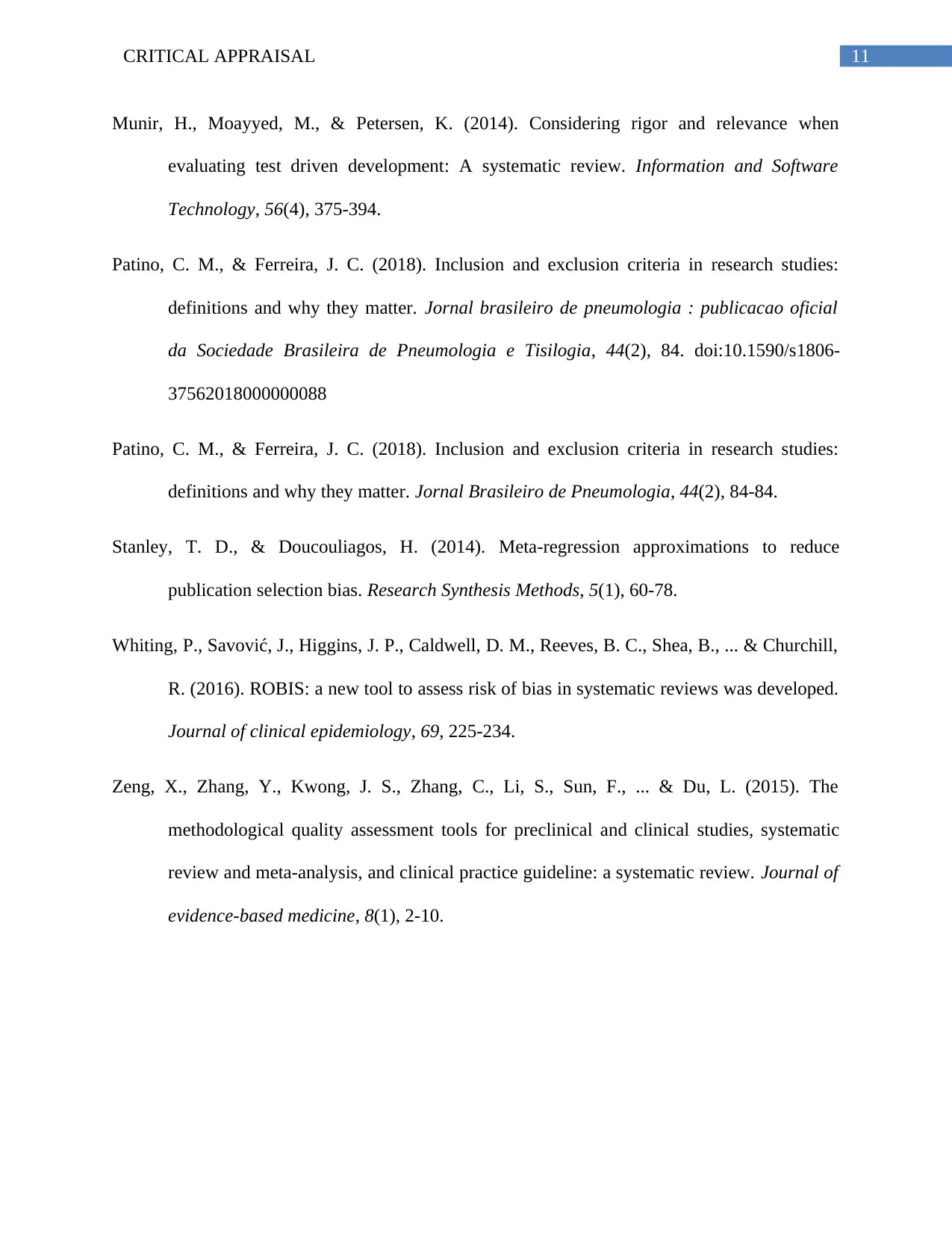
11CRITICAL APPRAISAL
Munir, H., Moayyed, M., & Petersen, K. (2014). Considering rigor and relevance when
evaluating test driven development: A systematic review. Information and Software
Technology, 56(4), 375-394.
Patino, C. M., & Ferreira, J. C. (2018). Inclusion and exclusion criteria in research studies:
definitions and why they matter. Jornal brasileiro de pneumologia : publicacao oficial
da Sociedade Brasileira de Pneumologia e Tisilogia, 44(2), 84. doi:10.1590/s1806-
37562018000000088
Patino, C. M., & Ferreira, J. C. (2018). Inclusion and exclusion criteria in research studies:
definitions and why they matter. Jornal Brasileiro de Pneumologia, 44(2), 84-84.
Stanley, T. D., & Doucouliagos, H. (2014). Meta‐regression approximations to reduce
publication selection bias. Research Synthesis Methods, 5(1), 60-78.
Whiting, P., Savović, J., Higgins, J. P., Caldwell, D. M., Reeves, B. C., Shea, B., ... & Churchill,
R. (2016). ROBIS: a new tool to assess risk of bias in systematic reviews was developed.
Journal of clinical epidemiology, 69, 225-234.
Zeng, X., Zhang, Y., Kwong, J. S., Zhang, C., Li, S., Sun, F., ... & Du, L. (2015). The
methodological quality assessment tools for preclinical and clinical studies, systematic
review and meta‐analysis, and clinical practice guideline: a systematic review. Journal of
evidence-based medicine, 8(1), 2-10.
Munir, H., Moayyed, M., & Petersen, K. (2014). Considering rigor and relevance when
evaluating test driven development: A systematic review. Information and Software
Technology, 56(4), 375-394.
Patino, C. M., & Ferreira, J. C. (2018). Inclusion and exclusion criteria in research studies:
definitions and why they matter. Jornal brasileiro de pneumologia : publicacao oficial
da Sociedade Brasileira de Pneumologia e Tisilogia, 44(2), 84. doi:10.1590/s1806-
37562018000000088
Patino, C. M., & Ferreira, J. C. (2018). Inclusion and exclusion criteria in research studies:
definitions and why they matter. Jornal Brasileiro de Pneumologia, 44(2), 84-84.
Stanley, T. D., & Doucouliagos, H. (2014). Meta‐regression approximations to reduce
publication selection bias. Research Synthesis Methods, 5(1), 60-78.
Whiting, P., Savović, J., Higgins, J. P., Caldwell, D. M., Reeves, B. C., Shea, B., ... & Churchill,
R. (2016). ROBIS: a new tool to assess risk of bias in systematic reviews was developed.
Journal of clinical epidemiology, 69, 225-234.
Zeng, X., Zhang, Y., Kwong, J. S., Zhang, C., Li, S., Sun, F., ... & Du, L. (2015). The
methodological quality assessment tools for preclinical and clinical studies, systematic
review and meta‐analysis, and clinical practice guideline: a systematic review. Journal of
evidence-based medicine, 8(1), 2-10.
1 out of 12
Related Documents
Your All-in-One AI-Powered Toolkit for Academic Success.
+13062052269
info@desklib.com
Available 24*7 on WhatsApp / Email
![[object Object]](/_next/static/media/star-bottom.7253800d.svg)
Unlock your academic potential
© 2024 | Zucol Services PVT LTD | All rights reserved.





